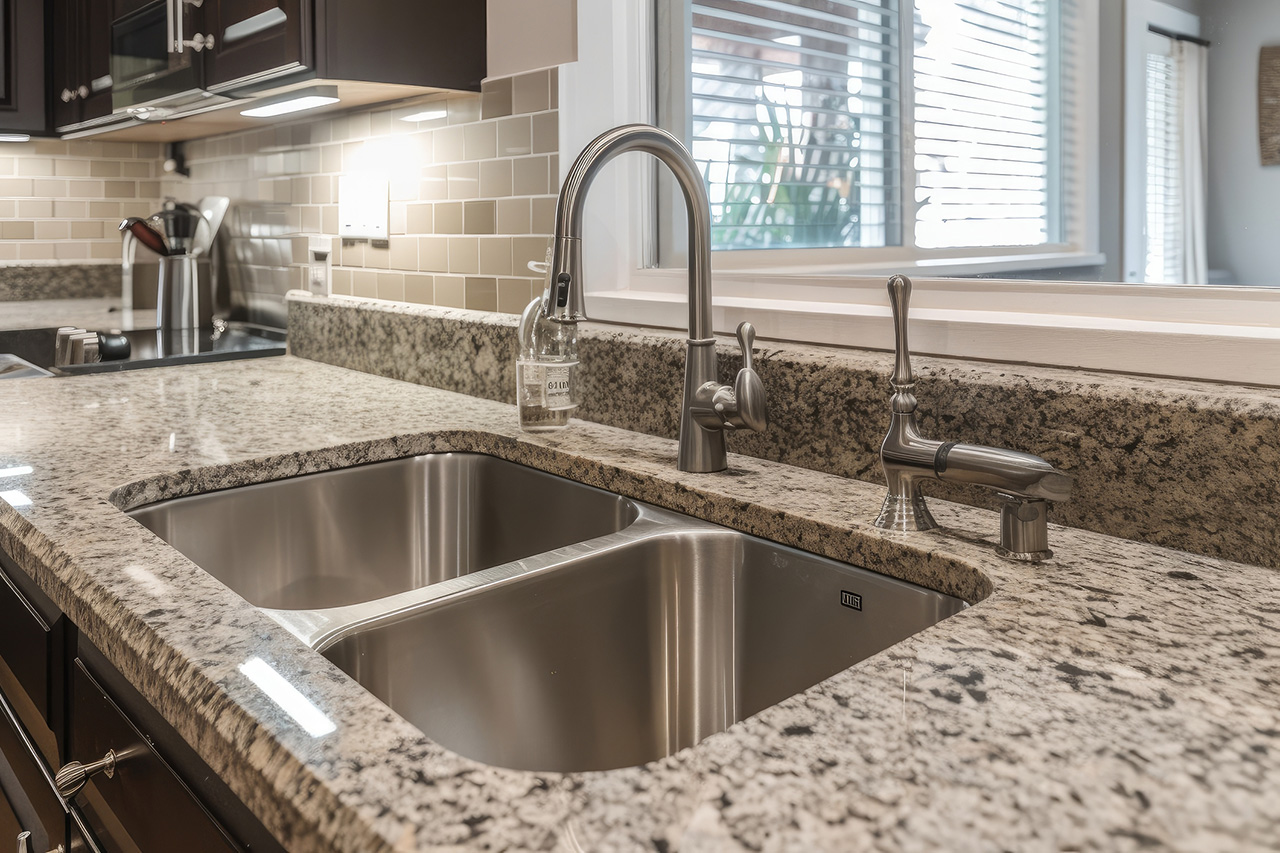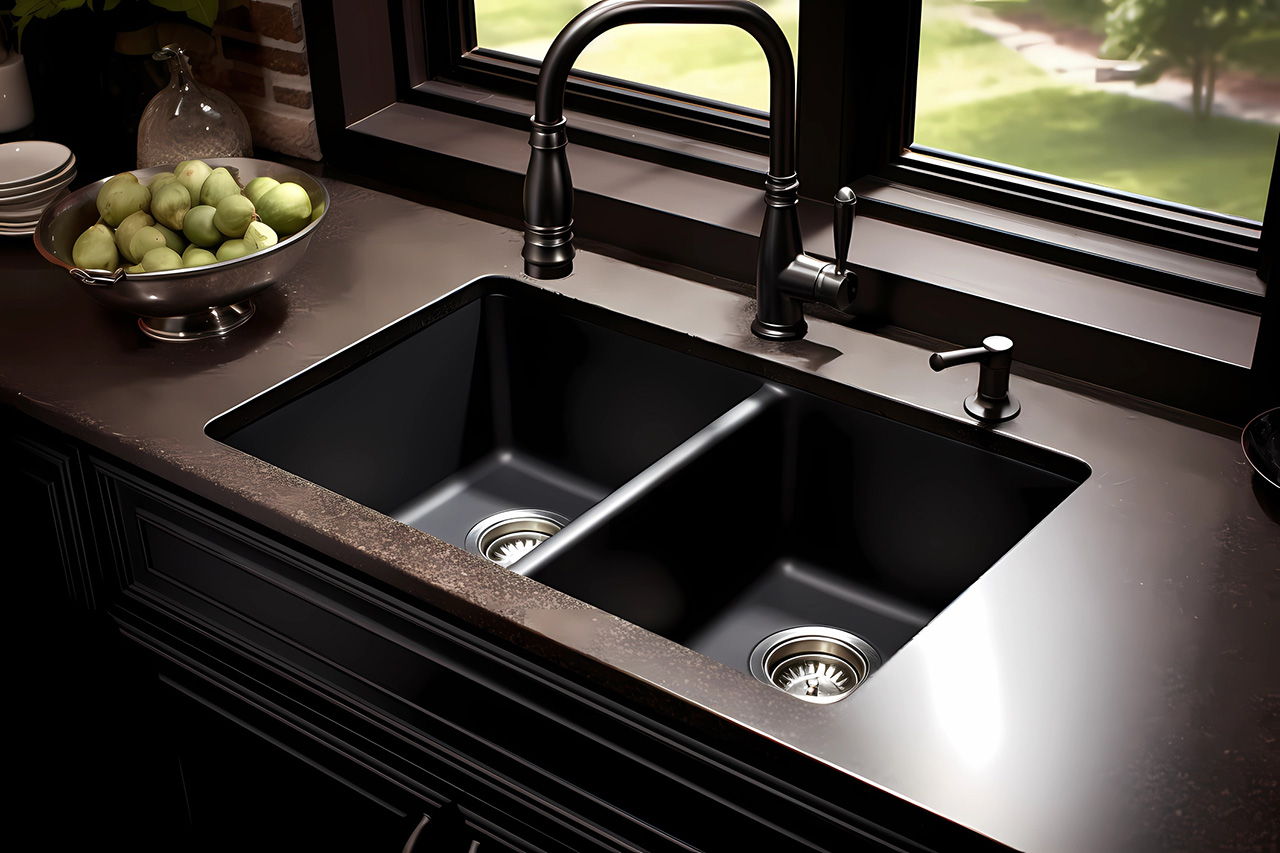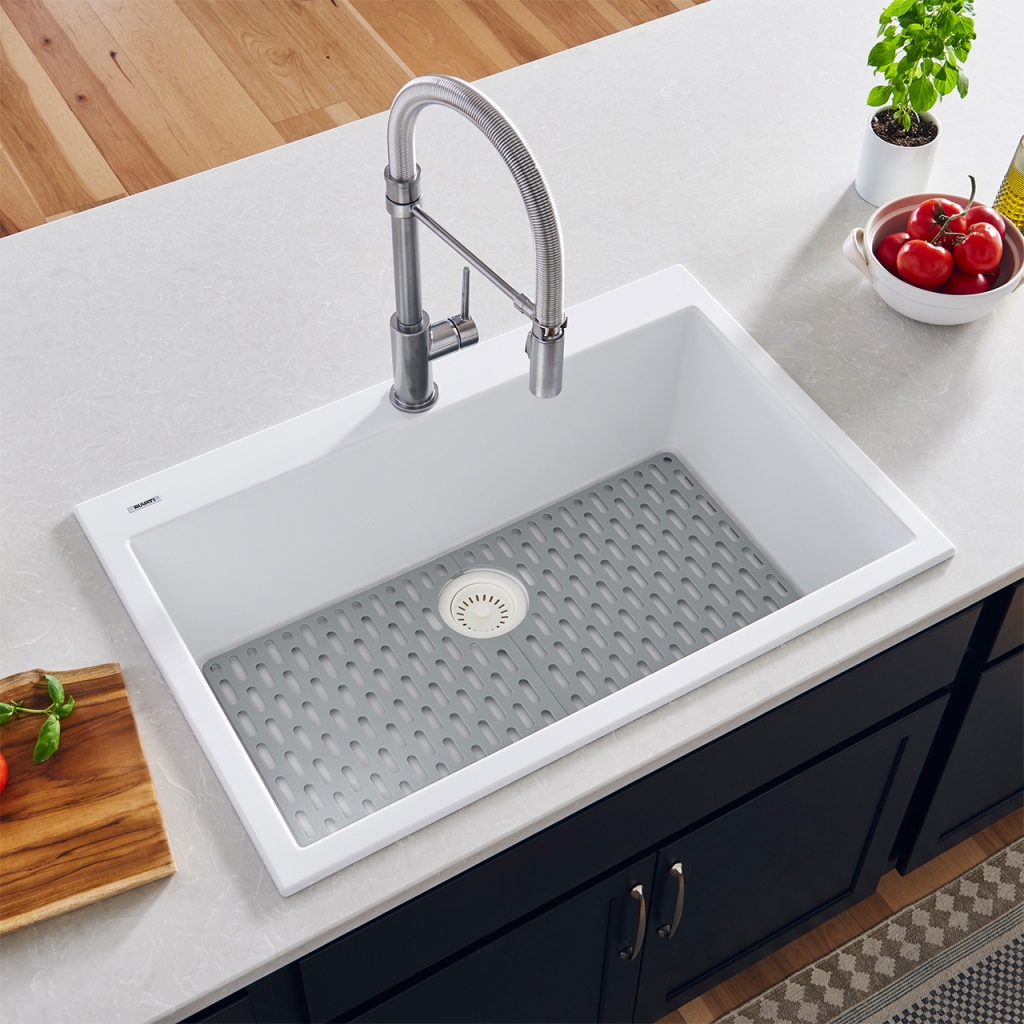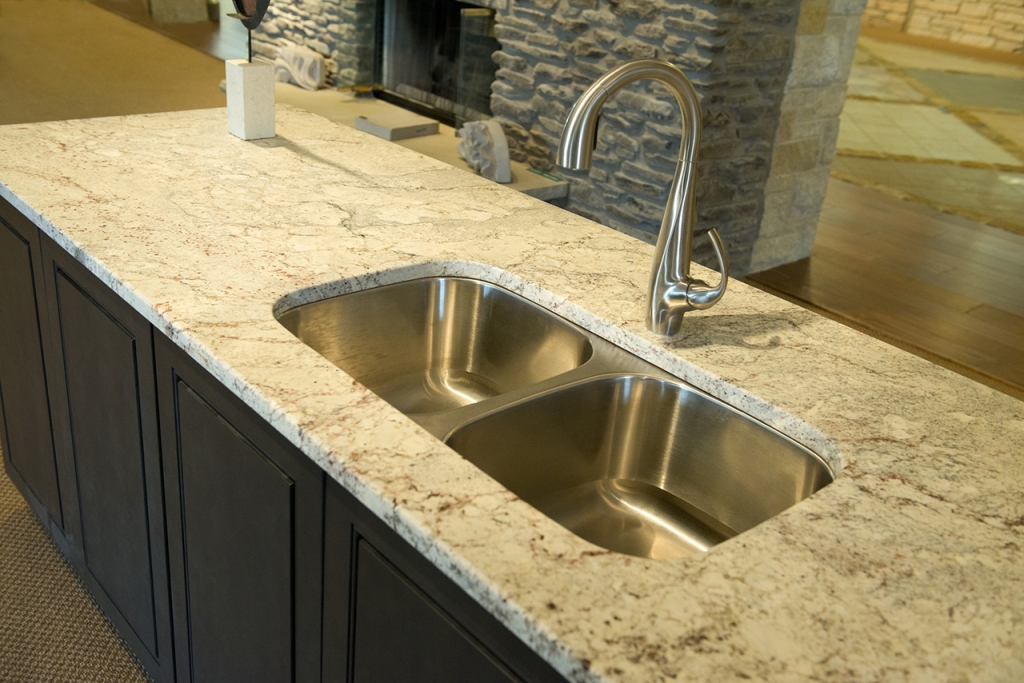Importance of matching kitchen sink with granite countertops
For several reasons, understanding how to match your kitchen sink with your Denver granite countertops is crucial. Firstly, it impacts the overall look and feel of the kitchen. When the sink complements the natural stone countertop, it creates a cohesive and visually pleasing aesthetic. The right combination can enhance the beauty of the kitchen, making it a more inviting and harmonious space.
Functionality is another key aspect to consider. A well-matched sink and countertop ensure that the workspace is practical and efficient. The perfect sink option can make food preparation and cleanup easier, while the granite countertops provide a durable, easy-to-maintain surface. A well-coordinated sink and countertop also contribute to the kitchen’s overall functionality, making it a more enjoyable and efficient space to work in.
Buying Guide: Denver Granite Countertops
Choosing the Right Sink Material
When it comes to choosing the right types of sink material for your kitchen or bathroom, there are a few popular choices to consider. The material of your sink can impact its durability, maintenance requirements, and overall aesthetic appeal.
With various options to choose from, such as stainless steel, cast iron, composite, and more, it’s important to understand the benefits and drawbacks of each material in order to make an informed decision that suits your needs and preferences. From durability and price to style and maintenance, selecting the right sink material is essential to any kitchen or bathroom design or renovation project.
Stainless Steel Sinks

One of the main advantages of stainless steel sinks is their exceptional durability. They are resistant to chipping, cracking, and rust, making them a long-lasting option for any kitchen.
Stainless steel sinks are also scratch-resistant, which helps maintain their sleek and polished appearance even after years of use. This makes them an ideal choice for busy kitchens where pots, pans, and utensils may come into contact with the sink on a regular basis.
In addition to being durable and scratch-resistant, they complement granite countertops beautifully, creating a seamless and modern look in any kitchen. They are available in both overmount and undermount styles, providing flexibility in terms of installation options.
Overall, stainless steel sinks are a practical and stylish choice for any kitchen, offering exceptional durability, scratch resistance, and easy maintenance.
Sinks Made of Composite Granite

Composite granite sinks are also popular for kitchen countertops due to their durability and scratch resistance. Two main types of composite granite sinks are available: Silgranit® and Granite Composite sinks. These sinks are made from a mixture of crushed granite stone and acrylic resins, which are then molded into the desired shape. This manufacturing process results in a very durable sink that is resistant to scratches, heat, and stains.
Silgranit® sinks, in particular, are known for their heat resistance, making them ideal for busy kitchen environments. Both Silgranit® and Granite Composite sinks come in a variety of colors and finishes, making it easy to find one that complements your granite countertops. These sinks are also non-porous, making them easy to clean and maintain.
Compared to traditional stainless steel sinks, composite granite sinks offer a more elegant and seamless look that complements the natural beauty of granite countertops. With their combination of durability, scratch resistance, and heat resistance, composite granite sinks are an excellent choice for any kitchen.
Cast iron sinks
Cast iron sinks are popular due to their exceptional strength and timeless appeal. The durability of cast iron makes it resistant to chipping, cracking, and burning, ensuring that it can withstand heavy use and last for many years.
One of the standout features of cast iron sinks is the colored enamel coating, which not only adds a beautiful, glossy finish but also allows for customization of color to match any kitchen decor. This coating also makes it easy to maintain and keep clean, as it resists stains and is non-porous, preventing bacteria and food particles from becoming trapped on the surface.
Overall, cast iron sinks offer a blend of strength, style, and customization, making them a popular choice for homeowners looking for long-lasting, low-maintenance kitchen fixtures.
Overmount sink

An overmount sink installation process involves mounting the sink over the countertop and “dropping” it into space, then securing it with a lip hanging over the countertop. The process includes cutting a hole in the countertop to fit the sink, sealing the rim to prevent water damage, and connecting the plumbing.
One potential issue with cleanliness and maintenance is that overmount sinks can collect crumbs, grime, and dirt around the rim, which can be challenging to clean. Additionally, the lip that hangs over the countertop can become a haven for bacteria and mold if not properly maintained.
Despite these drawbacks, overmount sinks are popular because they are easier to install and can be more cost-effective than under-mount sinks. However, it is important to regularly clean and maintain the area around the rim to prevent hygiene issues.
Undermount sink

Undermount sinks offer several benefits over traditional overmount sinks. Their sleek, modern design gives any kitchen or bathroom a sophisticated look. Additionally, under-mount sinks provide sanitary advantages by preventing water and food particles from getting trapped between the sink and countertop.
The installation process for under-mount sinks requires support from beneath the countertop to hold the sink’s weight. This support ensures that the sink is securely attached, preventing any risk of it falling. Specific types of under-mount sinks, such as Silgranit® or composite sinks, require additional support due to their heavy weight and material composition.
One of the main advantages of under-mount sinks is that they keep crumbs and water away from the countertop, making for easier cleanup and maintenance. The seamless installation also creates a seamless look, adding to the overall aesthetic of the kitchen or bathroom.
Single basin sink
A single-basin sink offers several benefits for kitchen spaces. Firstly, it frees up valuable countertop space by eliminating the divider that separates double sinks. This provides more room for meal preparation and other kitchen tasks. Additionally, the larger, uninterrupted basin of a single-basin sink makes it easier to clean larger cookware such as baking sheets and roasting pans.
Single basin sinks are available in various sizes, materials, and mounting options, making them suitable for various kitchen layouts and design preferences. This versatility allows for a customized look that complements the kitchen’s overall aesthetic.
Double basin sink
When considering double basin sinks for granite countertops, there are various sizes and configurations to choose from. The standard sizes have a wide range, from 33 inches to 48 inches, with options for equal or unequal basin sizes. Consider the space in your kitchen and the type of dishware you frequently use to determine the best configuration for your needs.
Double basin sinks are versatile for washing, rinsing, and draining dishware. They provide separate spaces for different tasks, which can efficiently streamline your dishwashing process. However, they may not be suitable for larger cookware due to the divided nature of the basins.
The benefits of a double basin sink include the ability to multitask and organize dishwashing duties. It can meet specific kitchen needs by providing separate spaces for washing delicate dishes and soaking pots and pans. Ultimately, the versatility of a double basin sink can make kitchen chores more manageable and efficient, especially for those who frequently use various types of dishware. With different sizes and configurations available, finding the perfect double basin sink to complement your granite countertops and your specific kitchen space is possible.
Considerations for Sink Colors
When selecting a sink color, there are several considerations to keep in mind. The color of your sink can greatly impact your kitchen or bathroom’s overall look and feel. From practical considerations like how well it hides stains and scratches to aesthetic considerations like how it complements your design style, the color of your sink can play a big role in your space. Keep reading for some key considerations when choosing a sink color.
Matching colors with granite countertops
When choosing a sink color to complement your granite countertops, there are several options to consider. Stainless steel sinks provide a modern and sleek look but can show water spots and scratches easily.
White sinks offer a classic and clean aesthetic, but may require more maintenance to keep them looking new. Black sinks can create a seamless and cohesive appearance with black countertops, but can also show water spots and soap scum.
Composite granite sinks blend in with the countertops for a seamless look and are durable, but may be limited in color options.
Copper or brass sinks add warmth and unique character to the kitchen, but can tarnish over time and require regular maintenance.
Key Considerations
When choosing a sink color, key considerations include personal preference, the kitchen’s overall style, and the desired level of contrast. Stainless steel may be the best option for a modern and sleek look. For a classic and clean kitchen, white sinks may be preferred. If you want to create a seamless appearance, composite granite sinks are a great choice. Ultimately, the sink color should complement the black granite countertops and enhance the kitchen’s overall aesthetic.

